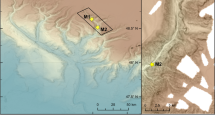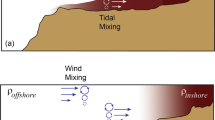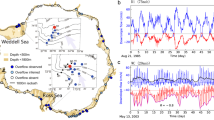Abstract
The continental slope is a steep, narrow fringe separating the coastal zone from the deep ocean. During low sea-level stands, slides and dense, sediment-laden flows erode the outer continental shelf and the continental slope, leading to the formation of submarine canyons that funnel large volumes of sediment and organic matter from shallow regions to the deep ocean1. During high sea-level stands, such as at present, these canyons still experience occasional sediment gravity flows2–5, which are usually thought to be triggered by sediment failure or river flooding. Here we present observations from a submarine canyon on the Gulf of Lions margin, in the northwest Mediterranean Sea, that demonstrate that these flows can also be triggered by dense shelf water cascading (DSWC)—a type of current that is driven solely by seawater density contrast. Our results show that DSWC can transport large amounts of water and sediment, reshape submarine canyon floors and rapidly affect the deep-sea environment. This cascading is seasonal, resulting from the formation of dense water by cooling and/or evaporation, and occurs on both high- and low-latitude continental margins6–8. DSWC may therefore transport large amounts of sediment and organic matter to the deep ocean. Furthermore, changes in the frequency and intensity of DSWC driven by future climate change may have a significant impact on the supply of organic matter to deep-sea ecosystems and on the amount of carbon stored on continental margins and in ocean basins.
This is a preview of subscription content, access via your institution
Access options
Subscribe to this journal
Receive 51 print issues and online access
$199.00 per year
only $3.90 per issue
Buy this article
- Purchase on Springer Link
- Instant access to full article PDF
Prices may be subject to local taxes which are calculated during checkout




Similar content being viewed by others
References
Posamentier, H. W., Jervey, M. T. & Vail, P. R. Eustatic controls on clastic deposition I – Conceptual framework. Soc. Econ. Paleontol. Miner. Spec. Publ. 42, 110–124 (1988)
Mulder, T., Weber, O., Anschutz, P., Jorissen, F. & Jouanneau, J. M. A few month-old storm generated turbidite deposited in the Capbreton Canyon (Bay of Biscay, SW France). Geo-Mar. Lett. 21, 149–156 (2001)
Khripounoff, A. et al. Direct observation of intense turbidity current activity in the Zaire submarine valley at 4000 m depth. Mar. Geol. 194, 151–158 (2003)
Paull, C. K. et al. Caught in the act: the 20 December 2001 gravity flow event in Monterey Canyon. Geo-Mar. Lett. 22, 227–232 (2003)
Puig, P. et al. Storm-induced sediment gravity flows at the head of the Eel submarine canyon, northern California margin. J. Geophys. Res. 109 C03019 doi: 10.1029/2003JC001918 (2004)
Whitehead, J. A. Dense water off continents. Nature 327, 656 (2002)
Shapiro, G. I., Huthnance, J. M. & Ivanov, V. V. Dense water cascading off the continental shelf. J. Geophys. Res. 108 3390 doi: 10.1029/2002JC001610 (2003)
Ivanov, V. V., Shapiro, G. I., Huthnance, J. M., Aleynik, D. L. & Golovin, P. N. Cascades of dense water around the world ocean. Progr. Oceanogr. 60, 47–98 (2004)
Lacombe, H., Tchernia, P. & Gamberoni, L. Variable bottom water in the Western Mediterranean Basin. Progr. Oceanogr. 14, 319–338, doi:10.1016/00796611(85)90015-1. (1985)
Durrieu de Madron, X., Zervakis, V., Theocharis, A. & Georgopoulos, D. Comments to "Cascades of dense water around the world ocean”. Progr. Oceanogr. 64, 83–90 (2005)
Béthoux, J. P., Durrieu de Madron, X., Nyffeler, F. & Tailliez, D. Deep water in the western Mediterranean: peculiar 1999 and 2000 characteristics, shelf formation hypothesis, variability since 1970 and geochemical inferences. J. Mar. Sys. 33–34, 117–131 (2002)
Lopez-Jurado, J. L., Gonzalez-Pola, C. & Velez-Belchi, P. Observation of an abrupt disruption of the long-term warming trend at the Balearic Sea, western Mediterranean Sea, in summer 2005. Geophys. Res. Lett. 32 L24606 doi: 10.1029/2005GL024430 (2005)
Flood, R. D. Classification of sedimentary furrows and a model for furrows initiation and evolution. Geol. Soc. Am. Bull. 94, 630–639 (1983)
Flood, R. D. Abyssal bedforms as indicators of changing bottom current flow: examples from the U.S. East Coast continental rise. Paleoceanography 9, 1049–1060 (1994)
Dasgupta, P. Sediment gravity flow—the conceptual problems. Earth-Sci. Rev. 62, 265–281 (2003)
Shapiro, G. I. & Hill, A. E. Dynamics of dense water cascades at the shelf edge. J. Phys. Oceanogr. 27, 2381–2394 (1997)
Masson, D. G., Kenyon, N. H. & Weaver, P. P. E. in Oceanography: An Illustrated Guide (eds Summerhayes, C. P. & Thorpe, S. A.) 146–151 (Manson, London, 1996)
Honjo, S., Manganini, S. M. & Wefer, G. Annual particle flux and a winter outburst of sedimentation in the northern Norwegian Sea. Deep-Sea Res. A 35, 1223–1234 (1988)
Yoder, J. & Ishimaru, T. Phytoplankton advection off the southeastern United States continental shelf. Cont. Shelf Res. 9, 547–553 (1989)
Hill, A. E. et al. The Malin cascade in winter 1996. J. Mar. Res. 56, 87–106 (1998)
Avril, B. DOC dynamics in the northwestern Mediterranean Sea (DYFAMED site). Deep-Sea Res. II 49, 2163–2182 (2002)
Earth Resources Information Systems Data Center. Global 30 arc second elevation data set. <http://edcwww.cr.usgs.gov/landdaac/gtopo30/gtopo30.html> (1996)
Somot, S., Sevault, F. & Deque, M. Transient climate change scenario simulation of the Mediterranean Sea for the twenty-first century using a high-resolution ocean circulation model. Clim. Dyn. doi: 10.1007/s00382-006-0167-z (published online, 20 July 2006)
HoughtonJ. T.et al. Climate Change 2001: The Scientific Basis (Cambridge Univ. Press, Cambridge, 2001)
Gregory, J. M. et al. A model intercomparison of changes in the Atlantic thermohaline circulation in response to increasing atmospheric CO2 concentration. Geophys. Res. Lett. 32 L12703 doi: 10.1029/2005GL023209 (2005)
Tsunogai, S., Watanabe, S. & Sato, T. Is there a "continental shelf pump" for the absorption of atmospheric CO2? Tellus B 51, 701–712, doi: 10.1034/j.1600-0889.1999.t01-2-00010.x (1999)
Cauwet, G. HTCO method for dissolved organic carbon analysis in sea water: influence of catalyst on black estimation. Mar. Chem. 47, 55–64 (1994)
Acknowledgements
This work was supported by the European Commission (EUROSTRATAFORM, EURODOM and HERMES projects), the Office of Naval Research, CNRS-INSU and the Catalan Government. Sediment cohesion data were provided by N. Sultan, N data by T. Tesi, and DOC data by M. Pujo-Pay. Multibeam bathymetry was collected in cooperation with Fugro Survey Ltd and AOA Geophysics. Contributions of the scientific and technical staff at the authors’ home institutions are warmly acknowledged. Author Contributions All authors contributed to the design and implementation of the experimental strategy. M.C. steered the integration and joint analysis of the data, interpreted side scan sonar data and wrote the final version of the paper in cooperation with S.H. P.P., X.D.d.M. and A.P. took the responsibility for time series, X.D.d.M. for hydrology data, and S.H. and J.F. for sediment trap data. All authors discussed the results and commented on the manuscript.
Author information
Authors and Affiliations
Corresponding author
Ethics declarations
Competing interests
Reprints and permissions information is available at www.nature.com/reprints. The authors declare no competing financial interests.
Supplementary information
Supplementary Notes
This file contains Supplementary Methods and Supplementary Figure Legends. (DOC 30 kb)
Supplementary Figure 1
Long term records from the Lacaze-Duthiers Canyon since October 1993. (PDF 21902 kb)
Supplementary Figure 2
Time integrated along-canyon cumulative suspended sediment transport for seven submarine canyons in the Gulf of Lion. (PDF 80 kb)
Supplementary Figure 3
Near-bottom time series of potential temperature, potential density anomaly, current speed and suspended sediment concentration. (PDF 219 kb)
Supplementary Figure 4
Time series before cascading (a) and during cascading (b) in winter 2004-05. (PDF 105 kb)
Supplementary Figure 5
C/N regression fit for trap particles collected in the Cap de Creus and Lacaze-Duthiers canyons during autumn stratified conditions and DSWC events. (PDF 126 kb)
Supplementary Figure 6
Coastal regions in the world where DSWC has been observed. (PDF 1110 kb)
Rights and permissions
About this article
Cite this article
Canals, M., Puig, P., de Madron, X. et al. Flushing submarine canyons. Nature 444, 354–357 (2006). https://doi.org/10.1038/nature05271
Received:
Accepted:
Issue Date:
DOI: https://doi.org/10.1038/nature05271
This article is cited by
-
Detailed monitoring reveals the nature of submarine turbidity currents
Nature Reviews Earth & Environment (2023)
-
Habitat Suitability Models of a Critically Endangered Cold-water Coral, Isidella Elongata, in the Mallorca Channel
Thalassas: An International Journal of Marine Sciences (2023)
-
50th anniversary review of the Mediterranean desiccation hypothesis
La Rivista del Nuovo Cimento (2023)
-
A bibliometric review of climate change cascading effects: past focus and future prospects
Environment, Development and Sustainability (2023)
-
Origin of submarine canyon-channel systems along the middle segment of West Mariana Ridge, Philippine Sea
Journal of Oceanology and Limnology (2023)
Comments
By submitting a comment you agree to abide by our Terms and Community Guidelines. If you find something abusive or that does not comply with our terms or guidelines please flag it as inappropriate.



